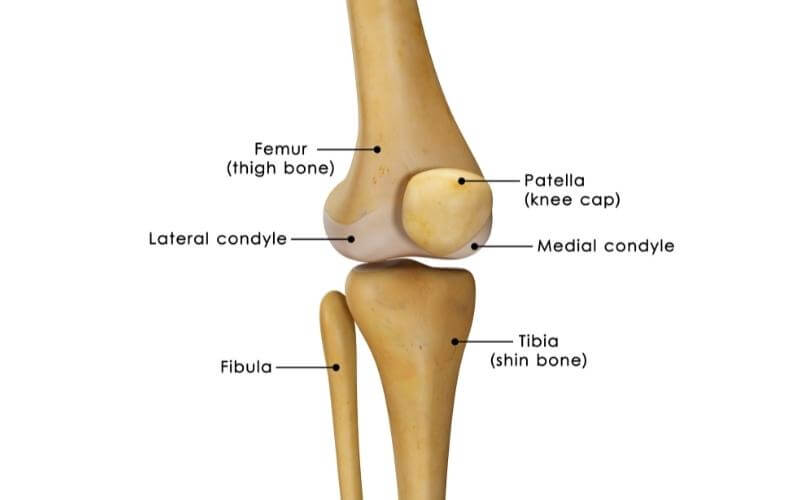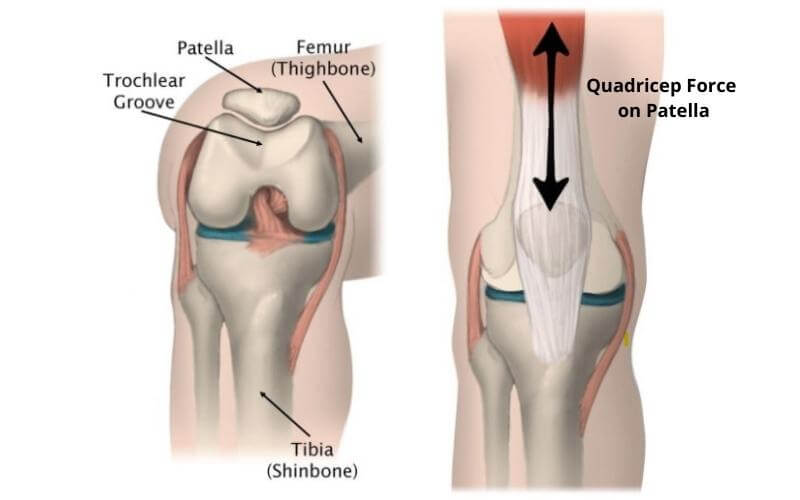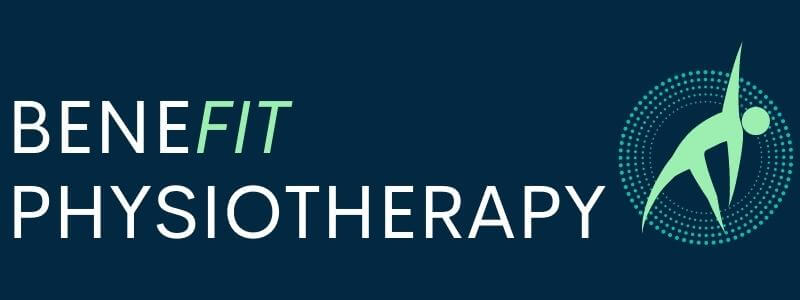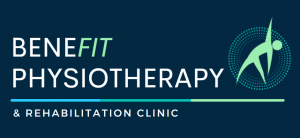Patellofemoral Pain Syndrome (PFPS) is one of the most common and most difficult knee injuries to manage. It is an injury faced by athletes of all shapes, sizes and skill levels.
The fact that it’s labelled as a syndrome tells us there is not one specific known structure causing the pain, which is what makes PFPS such a complex injury to treat. And often the underlying causes of the pain are not addressed, shown in the alarming number (70-90%) of individuals who experience recurring or chronic pain from PFPS.
However, with the correct guidance from your physiotherapist, with physiotherapy for patellofemoral pain you will be able to promptly manage the condition and prevent future reoccurrence.
What is the Patellofemoral Joint?
The word patellofemoral comes from a combination of two words – the patella (knee cap) and the femur (thigh bone).
So, the patellofemoral joint is the connection between the underside of the knee cap and the front of the thigh bone.

What are the Symptoms of PFPS?
The main symptom felt in PFPS in pain under or around the knee cap. This shouldn’t be mistaken for pain on the outside of the leg into the iliotibial band (ITB).
The pain is commonly aggravated by movements such as walking up or down stairs, squatting, lunging, kneeling and running. These movements place extra pressure onto the patella and irritate the surrounding tissues which causes the pain.
Sometimes the pain can be worse after long periods of sitting. You may also have mild swelling in the knee. The knee might feel stiff, but you should have full range of motion when bending and straightening the knee.
There is usually some clicking or grinding heard when moving the knee.

What causes the pain?
There is ongoing debate as to what causes the pain in PFPS. It seems that the pain develops not from the bone itself, but from the underlying inflammation in the patellofemoral joint which causes irritation in the surrounding soft tissues.
But the cause of the pain is only the first step. There can be a number of underlying reasons that you’ve developed this injury which need to be addressed. Some of them may not be coming from the knee!
Anatomy of the Patellofemoral Joint
The patella sits within a grooved surface on the femur called the trochlear groove. This provides stability to the joint and helps prevent dislocation. However, some people naturally have shallow grooves or have a patella which doesn’t sit in the centre of this groove. These individuals may be at a greater risk of developing PFPS.
Overlaying the patella is a structure called the quadriceps tendon. It extends from the quadriceps muscle, over the patella and connects into the top of the shin bone – using the patella as a lever to transmit force from the quadriceps muscle to the knee. Since the quadriceps are a major muscle group responsible for power and stability around the knee, weaknesses in this muscle can cause PFPS.

How to treat the pain PFPS?
The good news is there are some simple steps you can begin at home to start reducing the pain caused by PFPS. The first is reducing load by modifying or reducing your aggravating movements. If the pain occurs when running, stop running. If it occurs when kneeling on hard floors, kneel on cushions.
The next stage would be using ice packs. Applying an ice pack for 10-15 minutes directly to the painful region will help limit the inflammation in the joint and numb the pain. Have a look at our article on the benefits of ice packs to understand how icing helps injuries.
Further passive treatments like taping and bracing can also be used to reduce pain, however, discussing this with your physiotherapist is advised to ensure you have the best outcome.
Remember that these early treatments are pain relievers and not long-term solutions.
Identifying and eliminating the cause.
A skilled physiotherapist will be able to identify the causes of your injury. Once the cause is identified the rest should be simple – it may be some light massage and stretching, strength exercises of the hips and thighs, or simply changing some of your parameters around training.
The most common causes of PFPS are:
- Errors in training – Whether this is poor squatting technique or a sudden desire to master hill sprints, the amount of load you put through your kneecap will be directly correlated to the amount of pain you experience. But changing your training loads doesn’t necessarily mean giving up all together. It may just require a slight scale back while you work on other areas to resolve the injury.
- Muscle weakness – the two main muscle groups that influence the patella are the quadriceps (thigh muscles) and gluteals (buttock muscles). These are both require to maintain patella alignment and stability under high loads. Being specific about how we target these muscles is important and something your physiotherapist will be aware of. By gaining more strength you develop more stability and patella alignment which will reduce your pain.
- Poor flexibility – There is more force through the patella when the knee is bent. So it makes sense that if you’re unable to fully straighten your knee (hence the knee is constantly bent), you will be more likely to experience knee pain. Performing a flexibility program to help straighten the knee will reduce the strain on the patella and reduce patellofemoral pain. This can be achieved with some light stretching and foam rolling.
How Physiotherapy for Patellofemoral Pain can Help.
Physios are an essential for treating PFPS, especially when it has become chronic. Understanding the correct activity modifications and the most effective exercises to perform is essential in curing the injury. Your physiotherapist will take a detailed history and identify the most important components to your situation.
If your rehabilitation is done right, PFPS should be a thing of the past and you’ll be back to exercising in no time!
If you need help with PFPS, make an appointment with one of our experienced physiotherapists.
One-on-One Physiotherapy Care - Complete Attention - You Deserve It !
Contact Us today to find out how we can help you.


